By all accounts, 2018 was another extraordinary year for Greek archaeology. No crisis here, as archaeological discoveries and developments over the past twelve months have kept the media’s digital “presses” continuously rolling…
All across the country, Greek and foreign teams investigated a diverse range of archaeological sites, both on land and in the sea. From long-standing excavations at Akrotiri (Santorini), ancient Corinth, Eretria (Evia), Vergina and other major centers of the ancient Greek world, to small, dynamic, recently established research projects at other key sites, archaeologists from Greece and around the globe have all been “making the dust fly,” offering fresh, fascinating glimpses into prehistoric and classical life.
TOP ON-LAND DISCOVERIES AND DEVELOPMENTS OF 2018

© Hellenic Ministry of Culture and Sports
1. The Oldest Known Written Excerpt of Homer’s Odyssey
One particular highlight this year was the discovery of a clay tablet (3rd c. AD) at ancient Olympia, inscribed with thirteen verses from Homer’s Odyssey (Bk. 14). The Olympia inscription is likely the oldest-known surviving such written excerpt of the Odyssey discovered to date, and the first recording of Homer’s epic tale to be found on such a tablet.

© Black Sea Maritime Archaeology Project (MAP)
2. The Most Intact Ancient Greek Vessel Ever Found
A near-complete Classical Greek merchant ship (ca. 500 BC) lying upright and virtually undisturbed was recently discovered at the bottom of the Black Sea. The 2,400-year-old wreck – thanks to a deep, low-oxygen environment – has been preserved even down to its mast, twin rudders, and rowing benches, thus offering the possibility at last of illuminating the exact workings of the steering system and other key, long-enigmatic details in the construction of ancient wooden ships. Like a proverbial needle in a haystack, the 23 m-long vessel was detected some 43 nautical miles off the Bulgarian coast during a remote seabed-survey using deep-water cameras.

© Hellenic Ministry of Culture and Sports

© Hellenic Ministry of Culture and Sports

© Hellenic Ministry of Culture and Sports
3. Unlooted Tomb 1: Peloponnese
Unlooted chamber tombs, an eternal archaeological prize, have also come to light this year. An Early Mycenaean tomb discovered (1650-1400 BC) at Aidonia, near Nemea, contained four slab-covered graves sunk in the floor and an impressive array of burial goods: bronze swords and daggers, obsidian projectile points, pottery, beads, pins and stamps.

© Hellenic Ministry of Culture and Sports
4. Unlooted Tomb 2: Crete (Ierapetra)
In Crete, in the midst of an olive grove near Ierapetra, a farmer stumbled upon (and nearly into) a three-chambered tomb dating from the Late Minoan era (ca. 1400-1200 BC). Inside, archaeologists found two adult male skeletons – one of them in a large ceramic larnax (sarcophagus) with a pyramidal lid – and twenty-four “stirrup jars” for dispensing olive oil, several wine vessels and other pots.

© Hellenic Ministry of Culture and Sports
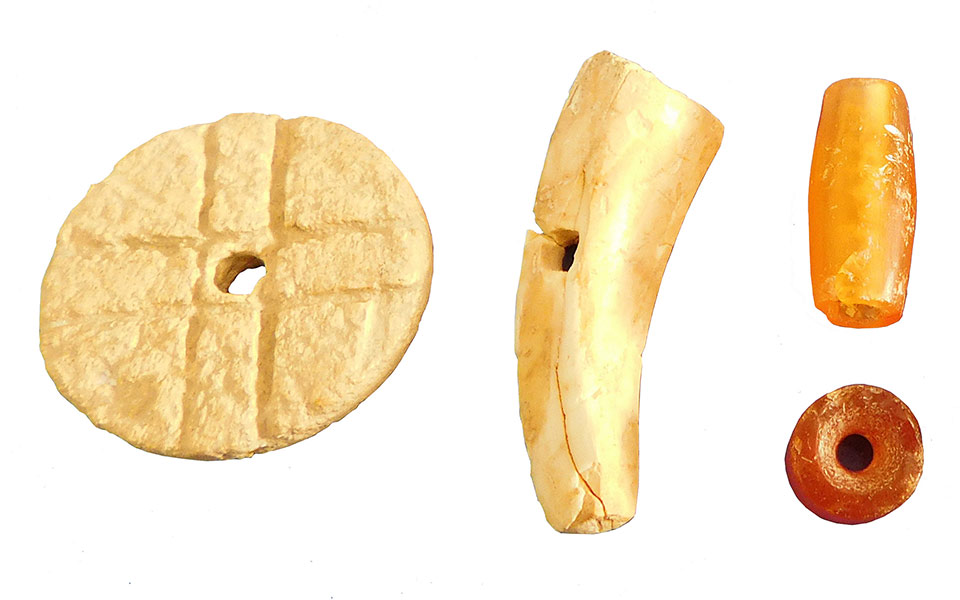
© Hellenic Ministry of Culture and Sports
5. Unlooted Tomb 3: Crete (Siteia)
Also in Crete, richly appointed pit graves, belonging to the Proto-Minoan II (2600-2300 BC) and Middle Minoan IA eras (2100-2000 BC), were excavated in the elite/royal necropolis at Petras, in Siteia, where ongoing investigations have revealed burials of a man, a woman and two children. Their grave goods included a bronze sword; dozens of spiral-decorated gold beads; hundreds of other gold, silver, crystal, carnelian and jasper beads from a garment; and two golden bracelets.

© S. Murray and C. Kolb CC BY-NC-ND 4.0
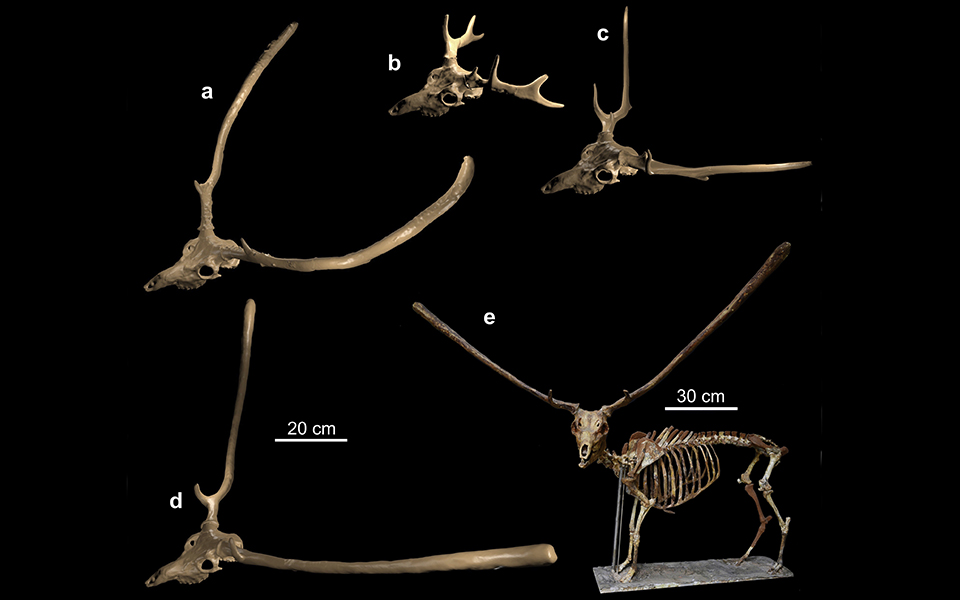
© G. Lyras, S. Murray and A. van der Geer, CC BY-NC-ND 4.0
6. Palaeolithic Dwarf Deer
One of the most important finds of 2018 has been the discovery of the earliest-known Greek art – petroglyphs inside Asfendou Cave (Sfakia, Crete), more than 11,000 years old, which provide an eyewitness account of the last Ice Age. Photogrammetry was used to detect 37 earlier engravings beneath already-known Bronze Age images, showing a herd of distinctively antlered, now long-extinct dwarf deer.

© Hellenic Ministry of Culture and Sports
7. Lost City of Tenea, Found!
Also exciting has been the confirmed identification of the ancient city of Tenea, about 14 km south of Corinth, believed to have been initially settled by Trojan captives after the sack of Troy, and only known previously through historical texts.
This year, architectural traces of the city’s residential area came to light, as well as an underground piping system, two infants’ tombs, pottery, jewelry, a bone gaming die and coins dating from late Classical through Roman times, some of them minted at Tenea. An affluent, independent, commercial city that flourished especially under the Romans, Tenea lay on a main route between Corinth and Argos.

© Dimitris Vlaikos
8. Santorini’s Eruption Redated
At the volcano-buried town of Akrotiri, on Santorini, prized possessions including a Proto-Cycladic white-marble female figurine, two small contemporary jars, a marble vial and an alabaster vase were found stored inside clay chests. In addition, more definitive dating evidence for the Santorini eruption has now emerged: a piece of charred olive wood recovered on the islet of Thirasia, shows – through radiocarbon analysis – that the massive prehistoric eruption, previously dated to ca. 1613 BC, actually occurred some decades later, in the early 1500s BC.

© Hellenic Ministry of Culture and Sports
9. Ancient Family Graves and Evidence of Thriving Trade Found in Thessaly
The extent of inter-regional trade in Greece in the 2nd millennium BC was further revealed in 2018 at the Bronze Age settlement of “Asvestaria” in western Thessaly in mainland Greece, where Cretan and Peloponnesian pottery items were unearthed alongside local wares.
This year marked the final campaign in a five-year project, during which 14 buildings and 42 graves from the Early to Late Hellenistic period have been brought to light. Poignant recent finds included a Bronze Age family (father, mother, infant) interred together in a pit grave, while, in another burial, a mother held a baby tucked against her chest. Beside still another child’s grave the skeleton of a pet dog was found.

© Hellenic Ministry of Culture and Sports
10. Samothrace Sanctuary Explored
In Samothrace, field research resumed after a 22-year hiatus at the Sanctuary of the Great Gods, where, in the 4th c. BC Alexander the Great’s parents, Olympias and Philip II, first met. Archaeologists began further exploring major structures at the sanctuary’s southwest corner, including the enormous Stoa (104 m long), the Theater and the Perivolos court where the famous Nike/Victory of Samothrace once stood (now in the Louvre). Work on a 3D digital model of the sanctuary continues.
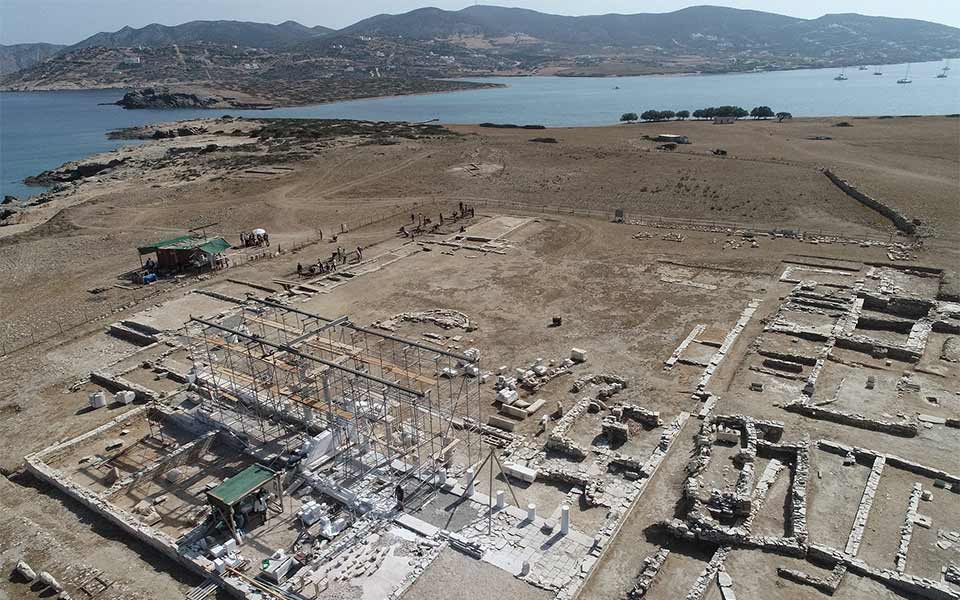
© Hellenic Ministry of Culture and Sports

© Hellenic Ministry of Culture and Sports

© Hellenic Ministry of Culture and Sports
11. New Finds on Uninhabited Island of Despotiko
On Despotiko islet, in the Cyclades near Antiparos, two new buildings, a probable courtyard, fifteen black-glazed oil lamps and other distinctive 6th-century-BC ceramic and metal artifacts were discovered the Archaic-era Apollo sanctuary of Mandra. This year’s digs, marking two decades of investigation, focused on the so-called Eastern Complex. Restorations also continued, with a third column now re-erected in the Apollo temple.

12. Light Shed on Ancient and Medieval Kythnos
Excavations on the northwestern side of the island of Kythnos (Vryokastro) were extended in 2018 to the nearby islet of Vryokastraki, where a suspected prehistoric settlement has now been identified. Rock-cut rooms, obsidian tools and pottery indicate the islet was occupied in the Early and Late Cycladic eras (4th-3rd, late 2nd millennia BC).
A newly discovered Early Christian basilica, with two later towers and stout exterior walls, attests to a resettlement of Vryokastraki in Early Christian times that persisted until at least the 7th or 8th century.

© Shutterstock
13. Corinth Goes High-Tech
The steady unveiling of ancient Corinth continued in 2018, with the excavators’ focusing on the area between the Theater and the Gymnasium. In a landmark move, after more than a century of digging, all excavation recording is now achieved directly from the trenches using iDig; supervisors upload field notes, contexts, objects, plans, drawings, photos, and conservation files into a single, integrated digital platform that promises greater ease and efficiency for post-season analyses. Recent finds included a record 705 ancient coins!
In another development, ancient Corinth is Greece’s first archaeological site to be preserved online in 3D digital imagery, as part of a project called Open Heritage, produced by Google Arts & Culture and CyArk. The project now provides virtual “tours” for remote visitors wishing to view ancient Greek monuments from the comfort of their laptops.
TOP UNDERWATER RESEARCH

© Hellenic Ministry of Culture and Sports

© Hellenic Ministry of Culture and Sports

© Hellenic Ministry of Culture and Sports
14. New Fourni Wrecks
Underwater research in 2018 has also been fruitful. Off the coast of the Fourni islands, in the long-notorious strait between Ikaria and Samos, five new shipwreck sites were discovered at depths of 10-40 m, to add to the 53 wrecks already documented there since 2015. Three of them were ancient (4th, 2nd c. BC; 5th/6th c. AD) and two early modern (18th or 19th c.).
Although the majority discovered to date belong to post-Byzantine or Byzantine times, a dozen Roman and three Archaic wrecks (6th c. BC) have also been detected. Newly recovered artifacts range from large transport amphorae, once containing oil, wine and other foodstuffs, to small Roman lamps (2nd c, AD), two bearing their Corinthian makers’ names, Octavius and Lucius.

© Hellenic Ministry of Culture and Sports

© Hellenic Ministry of Culture and Sports

© Hellenic Ministry of Culture and Sports
15. Probing the Ship that Sank with the parthenon marbles
Investigation of Lord Elgin’s ill-fated brig Mentor also continued in 2018, near Kythera island, where the infamous Malta-bound booty ship sank in 1802 while absconding with his marble treasures wrested from the Athenian Acropolis. Although the Parthenon Marbles were immediately salvaged, excavations today are revealing an assortment of small ancient Greek and Egyptian artifacts, as well as personal items of the crew and passengers including glass vials, clothing buttons and lead bullets. Examination of the ship itself in 2018 revealed that it was built in the then-newly-founded United States of America.

© Shutterstock
16. Mytilene’s Ancient Twin Ports
Another portion of the 3rd c. BC seaside fortification wall that once protected Mytilene’s northern port basin (Epano Skala) in Hellenistic-Roman times was uncovered in 2018, providing more clues to Lesvos island’s fascinating ancient topography. Mytilene’s strategic naval/commercial facilities originally consisted of two bustling harbors at opposite ends of a narrow strait separating a near-shore island from mainland Lesvos. Despite Roman repairs, this twin-basin port eventually fell into ruin as the strait silted in and a peninsula formed hosting what is now the unified town of Mytilene.
LABORATORY DISCOVERIES
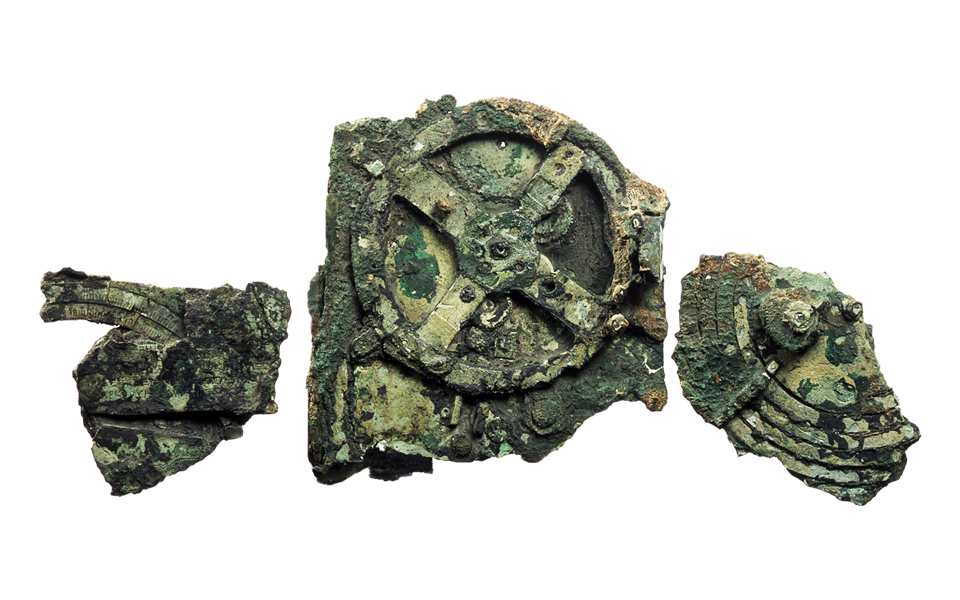
© National Archaeological Museum
17. New Piece of Antikythera Mechanism Discovered
Important discoveries were also made in the laboratory during 2018. Most striking: a new piece of the Antikythera Mechanism has been identified, following conservators’ removal of thick undersea encrustation and corrosion from an until-now mysterious metal object recovered during last year’s reinspection of the famous wreck site. Closely matching previously salvaged components of the world’s “first computer,” this bronze gear had four metal arms, attachment holes and a bull image engraved on one surface, possibly indicating it was designed to track the zodiac constellation Taurus.
18. Mysterious Pottery Traced to Evia Island
Chemical analyses of a ubiquitous but previously enigmatic type of pottery, “Middle Byzantine Production” (MBP), have at last determined that this popular class of trade goods originated in Chalcis in Evia. Although MBP has been found at archaeological sites from Marseilles to the Crimea, its source has remained a mystery.
To solve it, the chemical profiles of ceramic artifacts recovered from wrecks in the southern Evian Gulf were compared to known Chalcidean specimens. Chalcis was the port of inland Thebes – a thriving cultural/commercial center that, by the mid-12th century, had become the Byzantine empire’s largest producer of silks. Now we can conclude Byzantine Chalcis was a major exporter of not only Theban silks and regional agricultural goods, but also of its own MBP tableware.
THE YEAR IN SAVING & PROTECTING ANTIQUITIES
In 2018, rescue excavations in Greece have again been regular, almost daily events, many amounting to small operations conducted “just ahead of the backhoe” as a preliminary step to modern construction. Although they produce a constant trickle of new, sometimes valuable data on ancient Greek life, they seldom get reported in the media.
Intriguing recent finds include four marble “kouros” (male youth) statues fortuitously unearthed in Atalanti (1 hour east of Lamia) by a farmer planting olive trees. Despite their eroded, incomplete condition, these Archaic artworks, often associated with grave sites, were vital clues that led archaeologists to investigate further.
Deepening their trenches, they struck seven graves (5th – 2nd c. BC) of an organized necropolis, ascertained to belong to ancient Opus – the native city of the Iliad’s Patroclus, whose troops, according to Homer, were commanded at Troy by Ajax the Lesser, prince of Locris.

© Hellenic Ministry of Culture and Sports

© Hellenic Ministry of Culture and Sports
Northern Greece has been the scene of two massive archaeological “rescue digs” in 2018, associated with two major works: the Trans Adriatic Pipeline (TAP) and the Thessaloniki Metro.
TAP
As the TAP has steadily traversed the Greek countryside through the year, from Thrace to Kastoria, collaborating archaeologists have been furiously occupied recording more than 400 new sites exposed along the pipeline’s right of way.
The spectrum of cultural material revealed has been stunning, from scattered Neolithic artifacts, Early Bronze Age cemeteries and a Geometric-through-Hellenistic settlement and necropolis; to a Thracian coastal fortress of Philip II; Roman leather, wool, metal and pottery workshops; numerous Roman, Early Christian and Byzantine cemeteries; a three-apsed Early Byzantine basilica; and Post-Byzantine aqueducts. Occasionally, the sheer density of antiquities encountered has compelled the rerouting of the TAP.

THESSALONIKI METRO
Metro works in Thessaloniki have snarled life in the city center for years, but at last are slated for initial completion in 2020. Archaeologists continue to strive towards their goal of preserving the city’s heritage and displaying as much of the impressive, newly-found antiquities as possible in key station-museums and open-air exhibits.
Among 2018’s most notable findings are a statue of Aphrodite (4th c. AD) and an enormous Roman/Early Christian public fountain (15+ m long x 2.85 m high) at Aghia Sophia Station. Thessaloniki’s history is currently being rewritten, thanks to the discovery of more than 300,000 artifacts, thousands of graves and an entire preserved section of the central, marble-paved Decumanus Maximus road – beneath modern Egnatia Avenue – lined with ancient shops, colonnaded public spaces, a nymphaeum and affluent, mosaic-floored residences.
AN INTERNATIONAL AGREEMENT TO PROTECT BYZANTINE HERITAGE
To further protect important traces of the ancient Greek world, a milestone international agreement was signed in late 2018, in Thessaloniki, by more than twenty countries: the Charter for the Protection of the Byzantine Heritage Monuments. The Byzantine Empire lasted eleven centuries and spanned three continents. Its relics are divided among twenty-three distinct countries – all now encouraged through the charter’s principles to enact measures to protect, study and record the precious historical monuments they each contain. Notable among countries who have yet to join the accord are Turkey and FYROM.
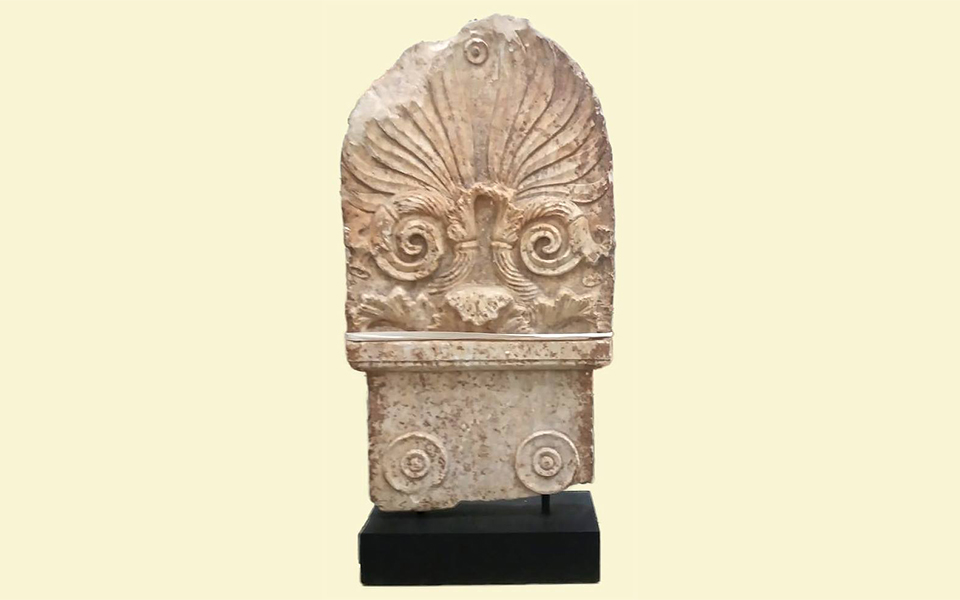
© Hellenic Ministry of Culture and Sports
Antiquity Thieves: Crime News from the Police Blotters
On the archaeological dark side, 2018 has also been an active year for antiquities thieves, smugglers and black market dealers. Police logs across the country read like excerpts from “Law and Order,” as authorities have scrambled to intercept ill-gotten ancient artifacts before they disappear into private collections or leave the country. In the spring, fifteen Bronze Age pots (17th c. BC) from Akrotiri were recovered after a night watchman and his accomplice were arrested in Santorini for looting the storeroom of the Archaeological Museum of Prehistoric Thira.
In a possibly related case, three men were snared in Loutraki, as one of them tried to sell a Roman statue of Aphrodite (2nd/1st c. BC) also stolen from Santorini. An antiquities ring was similarly captured in Sparti when three men tried to sell a Hellenistic or Roman statue of Hygeia (Health) to policemen posing as buyers.
Other artifacts recovered in 2018 include: three mosaic fragments stolen by a German tourist in the 1960s, who recently returned them by anonymous post to the Greek Embassy in Berlin; an Ionic column capital stolen from the Acropolis area and seized by police in Monastiraki; an elegant Attic grave stele (ca. 340 BC) carved with acanthus and rosette decorations, repatriated from London, where it was about to be auctioned off at Sotheby’s; and an official stele from a Hellenistic or Roman sanctuary or marketplace, bearing a lengthy Greek inscription (40+ lines), found hidden in a grain sack under stones on a country path in Evia.
In one of the stranger incidents, a summer forest fire in the mountains of Phthiotida (near Lamia) revealed to firefighters a cache of 200+ Geometric and Classical artifacts, apparently looted from graves of unknown location and left under bushes (now burned away) for later collection. The items, some stashed in plastic bags, included ceramic vessels, bronze bracelets and pins, a fragmented bronze mirror and numerous intact male, female and animal figurines. The police are investigating but note the area is notorious for illicit excavation.
NEW ARCHAEOLOGICAL MUSEUMS
Museum enthusiasts were treated in 2018 to the opening of two new history-related museums, one in Pylos (Peloponnese) and the other in Athens.

PYLOS
The new Archaeological Museum of Pylos is based inside the 16th-century fortress of Niokastro overlooking the port town, where exhibits shed light on Messinia’s rich past, including displays on the Palace of Nestor. The fresh experience now offered is actually a “three-for-one,” as visitors have the chance to explore the archaeological museum, the Ottoman fortress itself and the small but fascinating underwater archaeology museum also on the castle grounds.

© Nicholas Mastoras
Museum of Ancient Greek Technology
In Athens, the new Kotsanas Museum of Ancient Greek Technology has opened its doors in Kolonaki, where visitors will find over 100 meticulously researched and recreated ancient inventions, as well as 42 musical instruments. The working replicas of the main exhibition – all functional and most interactive – showcase the extraordinary level of technology achieved in Classical and Hellenistic times.
They include Hero of Alexandria’s “aeolipile” (the first steam engine) and his coin-operated vending machine for baptisms, which dispensed a portion of holy water; Ptolemy’s astrolabe; the Antikythera Mechanism, often described as the world’s earliest-known computer; Ctesibius’ water clock; and Philo of Byzantium’s human-like automatic “serving girl,” who could pour wine from a jug with her right hand into a cup held with her left, then add water if desired. Among the musical instruments are Pythagoras’ four-stringed “Helikon” and Hermes’ lyre.
TOP RESTORATIONS
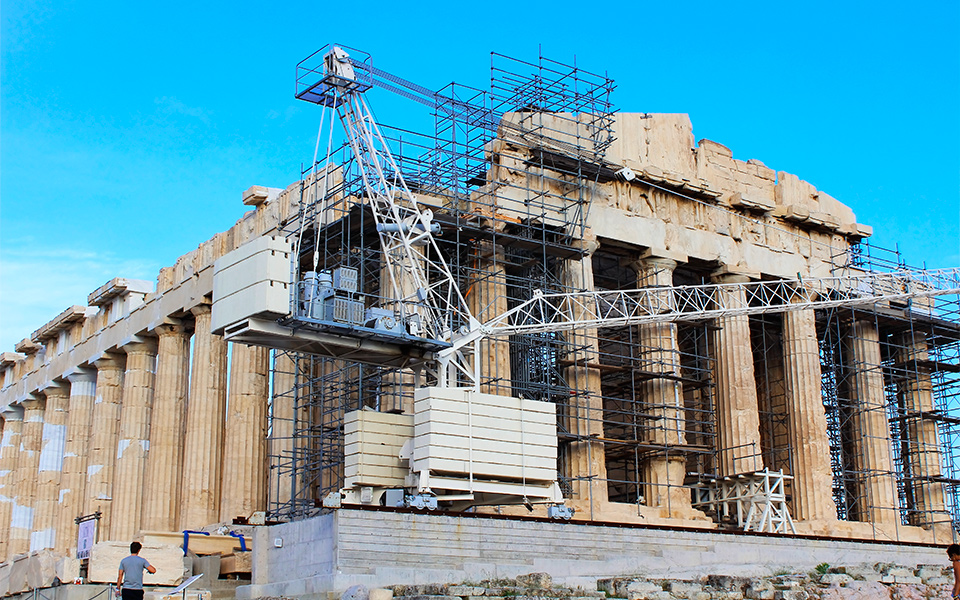
© Shutterstock
To preserve Greek archaeological sites and increase their comprehensibility, the Ministry of Culture conducted more than a dozen restoration projects in 2018, large and small, all across the country. Most prominent among them have been works on the west end of the Parthenon, aimed at amending the ill effects of previous interventions and improving the temple’s static strength.
In the Roman Agora, the beautifully restored 17th-century Fethiye Mosque went on display, an event celebrated with its hosting of a temporary exhibition entitled “Hadrian! Savior and Builder”.
Elsewhere, at Vergina, restoration of the Macedonian Palace of Aigai was finally completed and the panoramic hilltop site reopened to the public.
Two ancient theaters also began welcoming visitors again in 2018: at Aptera (near Chania), with dramatized narrations from Homer’s Odyssey, and in Eretria on Evia, where ongoing works have so far restored about 300 seats, already allowing audiences to enjoy performances of Euripides’ Eleni, Sophocles’ Oedipus Rex, and Aeschylus’ Persians.












